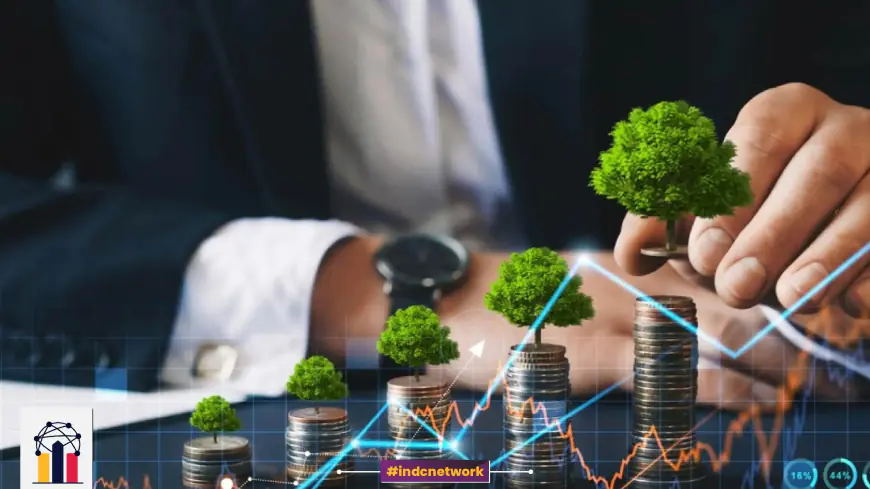Unlocking Hidden Investment Opportunities: Exploring Diverse Markets for Wealth Creation in 2024 and Beyond
The world of investment is vast and full of opportunities for wealth creation, but identifying the right avenues requires strategic planning and market understanding. This comprehensive article explores various investment opportunities, from traditional options like stocks and bonds to emerging areas such as cryptocurrencies, real estate, and sustainable investments. We delve into the risks, rewards, and future trends in each sector, offering insights to help investors navigate the shifting landscape in 2024 and beyond.

INDC Network : Business : Unlocking Hidden Investment Opportunities: Exploring Diverse Markets for Wealth Creation in 2024 and Beyond
The pursuit of wealth through smart investing is a goal that transcends time, geography, and socio-economic status. However, in a world that is constantly evolving, recognizing the best opportunities for investment can be challenging. Traditional investment vehicles such as stocks, bonds, and real estate continue to provide stability, but emerging sectors like cryptocurrencies, technology-driven innovations, and sustainability-focused funds are gaining traction, offering both opportunities and risks.
With financial markets more interconnected and technology-driven than ever before, navigating the investment landscape in 2024 requires both knowledge and agility. In this article, we explore a wide range of investment opportunities—both traditional and alternative—that offer the potential for wealth creation. Whether you're a seasoned investor or just starting, these insights will help you make informed decisions in a world brimming with possibilities.
The Core of Investing: Traditional Investment Vehicles : Before diving into alternative and emerging investment options, it’s important to understand the foundation of most investment portfolios: traditional assets. These investments have stood the test of time, providing stability and steady returns, especially for long-term investors.
1. Stock Market: Equities as a Cornerstone of Wealth Creation : Investing in the stock market remains one of the most popular and accessible ways to build wealth. Over time, equities have provided some of the highest returns compared to other asset classes, albeit with higher volatility. Companies that show consistent revenue growth, solid fundamentals, and long-term prospects tend to provide substantial gains to their shareholders.
Key Stock Market Strategies:
- Value Investing: Buying undervalued stocks with strong fundamentals, often trading below their intrinsic value.
- Growth Investing: Focusing on companies with significant growth potential, even if they appear overvalued in the short term.
- Dividend Stocks: Investing in companies that consistently pay dividends, offering income in addition to capital gains.
The rise of index funds and Exchange-Traded Funds (ETFs) has democratized access to the stock market. Investors can now easily diversify their portfolios by buying baskets of stocks that track broader indices (such as the S&P 500) or sectors like technology, healthcare, or emerging markets.
Emerging Trend: The increasing focus on Environmental, Social, and Governance (ESG) investing has influenced stock selection. Investors are now considering not just profitability but also how companies impact the environment, society, and their governance structures.
2. Bonds and Fixed Income: Stability and Predictability
Bonds and other fixed-income securities offer more stability than equities, making them a popular choice for conservative investors or those seeking to diversify risk. Bonds provide a predictable stream of income through interest payments, and their principal is returned upon maturity.
Types of Bonds:
- Government Bonds: These are typically the safest form of bonds, issued by national governments, with U.S. Treasury bonds being the benchmark for safety.
- Corporate Bonds: Issued by companies, these offer higher yields than government bonds but come with additional risk depending on the company's creditworthiness.
- Municipal Bonds: Issued by local governments, these often offer tax advantages, making them attractive to high-net-worth individuals.
Interest Rates and Bond Prices: Bonds are highly sensitive to changes in interest rates. As central banks like the Federal Reserve adjust interest rates, bond prices move inversely. In the current low-interest-rate environment, investors are exploring other fixed-income options, such as inflation-protected securities (TIPS) or high-yield corporate bonds.
3. Real Estate: A Tangible and Reliable Asset
Real estate has long been a staple in the portfolios of wealth-conscious investors due to its potential for steady income, capital appreciation, and inflation hedging. Whether through direct ownership of rental properties or indirect exposure via Real Estate Investment Trusts (REITs), real estate offers a unique blend of tangible security and income generation.
Types of Real Estate Investments:
- Residential Properties: Single-family homes, apartments, and vacation rentals. Rental income and property value appreciation provide returns.
- Commercial Properties: Office buildings, retail spaces, and industrial properties. Often more complex to manage but offer higher yields.
- REITs: A more liquid and accessible way to invest in real estate. These funds allow individuals to invest in a diversified portfolio of income-generating real estate assets.
Emerging Trend: With the rise of remote work and changing consumer behavior, logistics and warehouse real estate is becoming a hot area of investment, driven by e-commerce and global supply chains.
Alternative and Emerging Investment Opportunities
While traditional assets remain essential, modern investors are increasingly seeking alternative investment opportunities to enhance returns, hedge against inflation, and diversify risk. The following are some of the most promising areas to explore in 2024.
1. Cryptocurrencies and Blockchain Technology
Cryptocurrencies have moved from niche investments to mainstream opportunities, offering substantial returns for those willing to embrace volatility. Bitcoin, Ethereum, and other digital currencies are based on blockchain technology, which has the potential to revolutionize industries from finance to supply chain management.
Key Considerations:
- Bitcoin and Ethereum: The two largest cryptocurrencies by market capitalization. Bitcoin is seen as a store of value, while Ethereum is known for its smart contract functionality.
- Altcoins: Lesser-known cryptocurrencies that may offer higher returns but also carry more risk. Examples include Solana, Cardano, and Polkadot.
- Stablecoins: Digital currencies pegged to fiat currencies like the U.S. dollar, offering stability in an otherwise volatile market.
Blockchain Beyond Crypto: The underlying technology of cryptocurrencies—blockchain—has applications far beyond digital currency. Sectors such as healthcare, finance, and logistics are exploring blockchain for secure and transparent record-keeping, which presents new investment opportunities in blockchain-focused startups and companies.
Risks: Regulatory uncertainty remains a key challenge for cryptocurrency investments, with various governments still figuring out how to regulate and tax these assets.
2. Sustainable and Impact Investing
As awareness of environmental and social issues grows, so too does the appeal of sustainable and impact investing. Investors are increasingly prioritizing companies and funds that align with their values, particularly in areas such as climate change, renewable energy, and social equity.
- ESG Investing: Environmental, Social, and Governance (ESG) investing focuses on companies that demonstrate good practices in these three areas. ESG funds have gained popularity due to their focus on long-term sustainability and ethical business practices.
- Impact Investing: This involves investing in companies, organizations, or funds with the intention of generating measurable social or environmental impact alongside financial returns. Popular sectors include clean energy, water conservation, and affordable housing.
- Green Bonds: These are bonds specifically designed to finance environmentally friendly projects, such as renewable energy or clean transportation infrastructure.
Emerging Trend: Carbon credits and renewable energy investments are becoming attractive to investors seeking both financial returns and a positive environmental impact. These investments help fund projects that reduce carbon emissions and promote cleaner energy.
3. Private Equity and Venture Capital
Private equity and venture capital offer exposure to businesses at different stages of growth, from startups to established companies looking to expand. While these investments can be more illiquid and risky, they also have the potential for outsized returns.
- Venture Capital (VC): VC firms invest in early-stage startups with high growth potential. These companies are often in sectors such as technology, biotech, and fintech. While risky, successful investments can yield significant returns when startups go public or are acquired.
- Private Equity (PE): PE firms typically invest in mature companies, often restructuring or optimizing operations to improve profitability before selling or taking the company public. These investments require significant capital and a long-term horizon but can provide solid returns.
- Emerging Trend: SPACs (Special Purpose Acquisition Companies) have gained attention as a way for private companies to go public without a traditional IPO. While SPACs can offer lucrative opportunities, they also carry higher risks due to their speculative nature.
4. Commodities and Precious Metals : Investing in commodities, such as gold, silver, and oil, can provide a hedge against inflation and market volatility. These assets tend to perform well in times of economic uncertainty or currency devaluation.
Key Commodities:
- Gold and Silver: Traditionally seen as safe-haven assets, especially during economic downturns.
- Oil and Natural Gas: Energy commodities that play a vital role in the global economy. Prices can be influenced by geopolitical factors, supply, and demand dynamics.
- Agricultural Commodities: Investments in products like wheat, corn, and soybeans. These are often linked to global supply chains and can be volatile due to weather patterns and trade policies.
Emerging Trend: Green commodities, such as those tied to renewable energy infrastructure (e.g., lithium for batteries), are gaining interest as the world transitions to a greener economy.
What's Your Reaction?














































































































































































